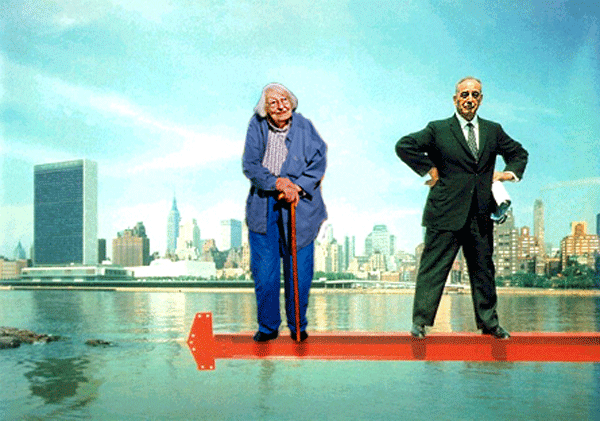-
Who’s Afraid of Robert Moses?
by Margaret Eby March 29, 2010

The Battle for Gotham: New York in the Shadow of Robert Moses and Jane Jacobs by Roberta Brandes Gratz. (Nation Books, April 2010)
In 2009, Janette Sadik-Khan, the lithe, stylish Transportation Commissioner of New York City, cut the ribbon on Times Square’s newest makeover. Sadik-Khan, under the direction of Mayor Michael Bloomberg, had closed Broadway to automobile traffic from 42nd to 47th streets, transforming Manhattan’s famed neon temple into a vast pedestrian plaza, sprinkled with metal beach chairs and concrete planters. “Streets are public space,” Sadik-Khan later proclaimed at a lecture at Occidental College, “We want to see streets for the people.” Her detractors accused her of hindering circulation; her supporters hailed her as a visionary, a worthy diplomat in the constant struggle between New Yorkers on foot and those behind the wheel. An article in New York Magazine claimed Sadik-Khan as a luminous compromise between mayoral bureaucracy and neighborhood-level planning, “equal parts Jane Jacobs and Robert Moses.”
For any city planner, architect, advocate, or transportation engineer in New York, a comparison to either Jacobs or Moses is inevitable. The rivalry between Jacobs, an architecture critic and community organizer who fought for an organic approach to neighborhood rehabilitation, and Robert Moses, grand poobah of New York City public works for some 30 years, is the most famous city-planning clash of the 20th century. In New York, both figures’ philosophies are inescapable, inscribed into the very streetscape of the city—no corner park, glass-paneled hotel building, or traffic plan can escape association with either Moses’s large-scale clearance programs or Jacobs’ community-based revitalization efforts. Often, real-estate developers and municipal officials claim pieces of both legacies, citing the grandness of Moses’s ambition and Jacobs subtler, interventionist approach.
To journalist and urban critic Roberta Brandes Gratz, author of The Battle for Gotham: New York in the Shadow of Robert Moses and Jane Jacobs, the idea of mixing Moses’s and Jacobs’s theories is laughable. “Trying to blend Moses and Jacobs is like trying to push together the old black-and-white Scottie dog magnets: the harder you push the more resistance you feel.” The Battle for Gotham mixes Gratz’s personal manifesto against the planning practices and ideological approach of Robert Moses with recollections from her childhood in Greenwich Village, investigations from her reporting days at The New York Post, and accounts of the destruction various Moses projects wrought upon the urban fabric of the city. It’s a confusing hodgepodge, part policy critique and part memoir it’s a litany of complaints as much as it’s an analysis.
In the book, Moses emerges as a kind of urban-studies super-villain, the tyrannical, automobile-friendly Goliath to Jacobs’ pedestrian-defending David. This is Disney movie stuff: the scrappy, bespectacled community advocate versus the big-government, cigar-chomping transportation boss. His policies are to blame for the city’s decline into near-bankruptcy; his eventual defeat by bands of Jacobs-inspired grassroots planners the reason for New York’s revival since the 1970s. Gratz’s loyalty to Jacobs is unwavering, her depictions of Moses scathing and resolute:
No matter that in his early good government career Moses was a legitimate reformer, no matter how noble one thinks Moses was because he amassed only unbridled power and not bags of money for himself, no matter how wonderful one might judge Moses’s parks, he was probably the most undemocratic, arrogant, ruthless, and racist unelected government official of the twentieth century.
Gratz’s position isn’t an unusual one: Moses’s reputation has long been in shreds, and Jacobs’s theories championed as a panacea for any number of urban woes, from racial clashes to the MTA’s budget deficit.
It’s an attractive dichotomy, and Moses makes a good target. Doubtless, Moses’s idea of the city as a nexus of cloverleafs and expressways clashes with the sustainable, foot traffic-friendly version favored today. Certainly, Moses’s slum-clearance projects displaced hundreds of families and businesses and hastened the decline of working-class neighborhoods, partitioning the metropolis instead of knitting it together. Without question, New York would be a very different place if not for Jacobs’s impassioned activism against the Lower Manhattan Expressway, originally slated to demolish SoHo. But to lay the blame squarely at Moses’s feet for everything from the new Yankee Stadium to Atlantic Yards is too easy; it denies the very richness and complexities of the urban fabric celebrated so memorably by Jacobs. To treat Moses as a straw man and Jacobs as a saint ignores the national, economic, and societal forces that shape the city just as surely as city planners and neighborhood organizations.
Gentrification is the unacknowledged elephant stomping through Battle for Gotham, the consequence of the influx of upper-middle-income families back into the refurbished city. Gratz extols the virtues of Greenwich Village and SoHo, but has little sympathy for the small businesses and lower-income residents forced out by the influx of upscale retailers. “Whatever and whoever have left exist elsewhere,” she writes, “Some of the very people leaving SoHo and moving elsewhere are helping the process take hold in emerging SoHo-type districts in other cities.”
It’s a remarkably tone-deaf position, one that gives little consideration to the class segregation that occurs in cities like New York. The displacement of long-time residents in Bushwick and Harlem may result from rising rents rather than demolishing wide swaths of the city, but it is displacement nonetheless, and an equal threat to the mixed-income communities Jacobs celebrated in her Death and Life of Great American Cities. The structural and economic dilemmas New York City faces never came from just one man; the historical forces shaping the city came into play long before Moses signed on as Parks Commissioner. Nor did Jacobs, for all her astute observations about community conservation, have all the solutions for an ever-evolving metropolis. Both figures loom large over the city, but they cast only shadows. The victories—and failures—of New York can’t be attributed to either of them alone. They belong to all of us.

